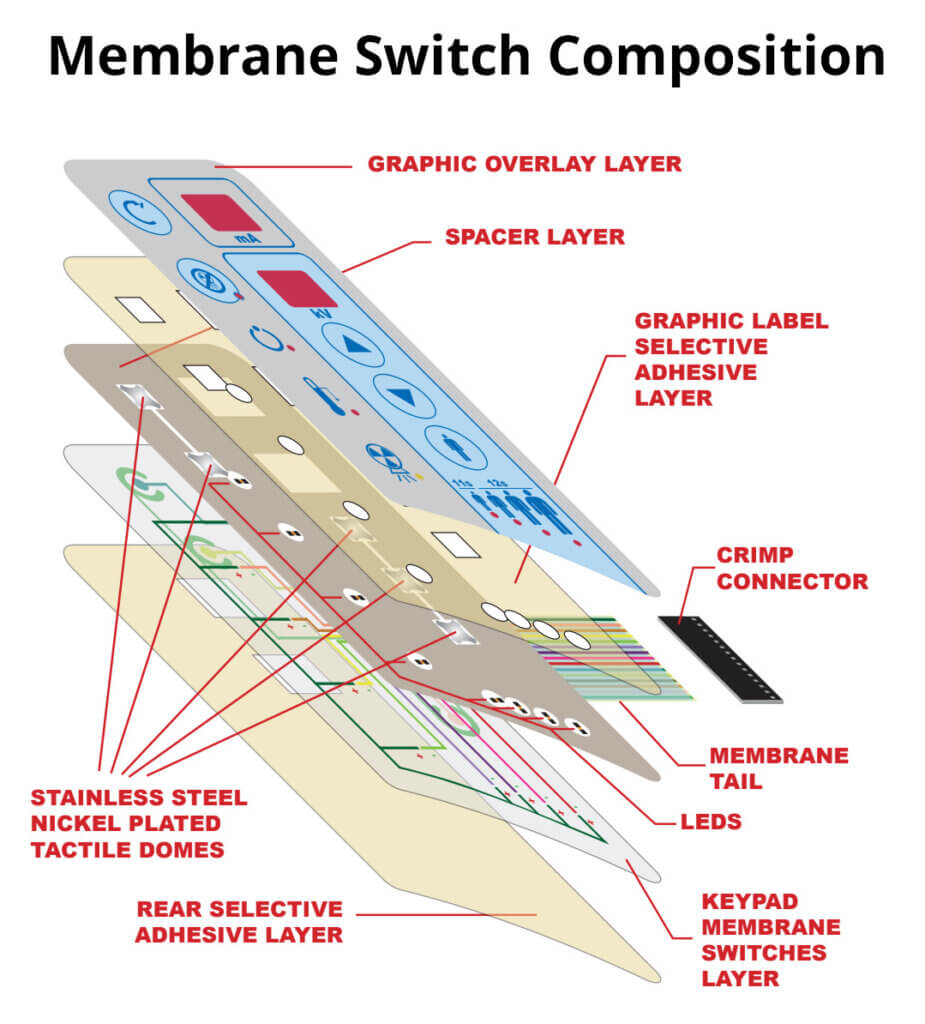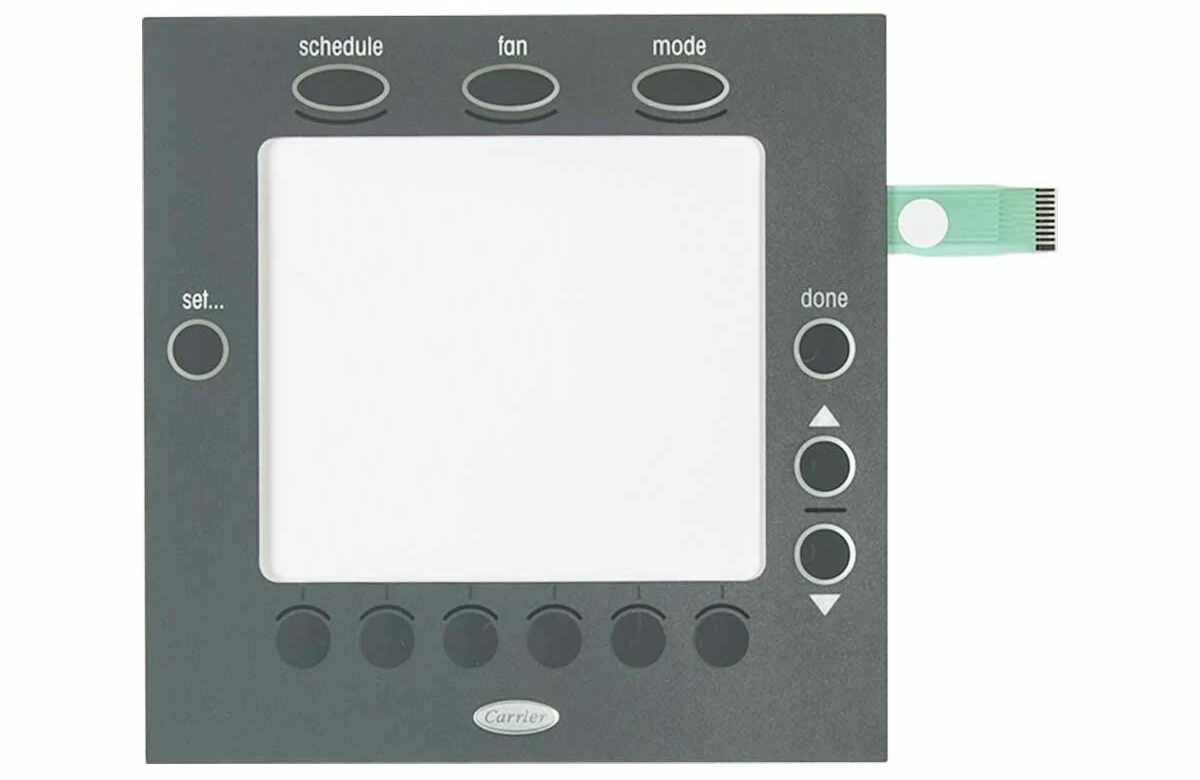Learn Why We’re a Trusted Membrane Switch Manufacturer
Wiki Article
Understanding the Significance of Membrane Switch in Modern Electronics and Their Applications
Membrane switches over serve as an important part in modern-day electronics, using a reliable user interface for customer communication. Their personalized and light-weight nature makes them appropriate for a series of applications across diverse industries. Comprehending their crucial parts and benefits can supply insights into their expanding importance. As technology proceeds to advancement, the evolution of Membrane changes increases questions concerning their future applications and layout developments. What lies in advance in this vibrant field?
What Are Membrane Buttons?
Membrane buttons are necessary parts in contemporary electronics, acting as user interfaces that facilitate interaction between customers and gadgets. These switches include a number of layers, consisting of a visuals overlay, an adhesive layer, and a circuit layer, every one of which collaborate to create a long lasting and useful interface. The design permits a flat, low-profile remedy that can be tailored concerning dimension, form, and visual appearance, making them suitable for numerous applications, from customer electronics to medical devices. The responsive comments supplied by Membrane switches over enhances user experience, while their resistance to dust and dampness makes them suitable for testing settings. Furthermore, Membrane buttons can incorporate functions such as backlighting and printed graphics, better broadening their functionality. Their convenience and toughness make them a recommended selection in markets where integrity and convenience of use are paramount, eventually adding to the smooth procedure of modern-day digital devices.Key Parts of Membrane Changes
While various elements add to the capability of a membrane switch, three primary layers play substantial duties in its style and operation. The top layer, commonly made from a long lasting polymer, works as the interface for user communication, typically featuring printed icons and graphics. Beneath this is the spacer layer, which maintains the necessary range between the leading layer and the circuit layer. This spacer layer guarantees that the switch activates only when pushed, protecting against unintentional inputs. The circuit layer includes conductive traces that finish the electric circuit when the leading layer is dispirited. These traces can be made from various materials, consisting of copper or silver. With each other, these parts develop a durable and reputable gadget that is compact and functional, appropriate for a variety of digital applications, from home devices to clinical gadgets. Comprehending these vital elements is important for valuing the overall capability of Membrane buttons.Benefits of Making Use Of Membrane Changes

Membrane Switch Manufacturing Process
Comprehending the Membrane switch manufacturing process discloses the intricate actions entailed in creating these vital elements. The procedure typically starts with the design stage, where requirements and designs are produced making use of specialized software application. Following this, the graphic overlay is printed on a versatile substrate, typically using high-resolution printing techniques to ensure quality and precision.Next, the adhesive layers are applied, which offer to bond the various parts with each other. The circuit layers, made from conductive inks or materials, are then printed onto a separate substratum. These layers are very carefully straightened and laminated flooring to produce a practical switch.After assembly, the buttons go through checking to verify performance and sturdiness. Quality control procedures are carried out throughout the process to determine and rectify any kind of flaws. Finally, the completed Membrane switches are packaged and gotten ready for distribution, all set to meet the demands of contemporary digital applications.Applications of Membrane Switches Over in Various Industries
Membrane switches are progressively utilized across different industries, especially in clinical equipment and consumer electronics. In the clinical field, they supply trusted control interfaces for tools that call for specific procedure. In customer electronic devices, these switches enhance customer communication by offering sleek and receptive interfaces. Receptive Medical Tools Control Many modern-day clinical gadgets use Membrane switches for structured procedure and boosted individual interaction. These switches provide a trusted, long lasting interface for a variety of applications, consisting of analysis equipment, individual surveillance systems, and surgical instruments. Their personalized designs enable details layouts that can accommodate the unique demands of medical care professionals, making sure user-friendly navigating and effective accessibility to necessary functions. Furthermore, Membrane buttons are resistant to contaminants, making them appropriate for sterilized environments. The tactile feedback they provide can enhance individual self-confidence, minimizing the danger of mistakes during important medical treatments. Overall, the integration of Membrane switches in clinical equipment substantially adds to boosted operational effectiveness and individual safety in healthcare setups.
Consumer Electronic Devices Interfaces
In the domain of customer electronic devices, Membrane buttons play a crucial duty in enhancing interface across a wide variety of devices. These buttons are essential to items such as push-button controls, microwaves, and pc gaming consoles, offering a user-friendly and effective interface. Their layout allows for a smooth combination of graphics and functionality, allowing makers to create smooth, modern aesthetic appeals without compromising usability. Membrane buttons are also understood for their sturdiness, commonly holding up against considerable use and exposure to numerous environmental problems. Furthermore, they can integrate attributes like backlighting and tactile look at these guys feedback, more enhancing the customer experience. As consumer demands for advanced yet intuitive user interfaces expand, Membrane switches over remain to be a necessary element beforehand digital device performance.Layout Considerations for Membrane Switches
Designing reliable Membrane switches needs mindful attention to numerous variables that affect both functionality and customer experience. One important factor to consider is the option of materials, as they can impact durability, responsive responses, and aesthetic charm. Selecting a suitable adhesive is vital for assuring long-term bond and resistance to ecological factors.In addition, the design and style of the button must fit individual interaction, with switch sizes and spacing maximized for convenience of use. The consolidation of graphics and labeling need to prioritize clearness and presence under numerous lighting conditions.Consideration of electrical qualities, such as actuation force and switch level of sensitivity, will boost the responsiveness of the Membrane button. Moreover, the style needs to accommodate manufacturing processes to ensure cost-effectiveness and prompt production. In general, a well-balanced design boosts both the customer and the performance experience of Membrane buttons in modern-day electronic devices.
Future Patterns in Membrane Switch Innovation
As technology proceeds to evolve, Membrane buttons are poised to incorporate brand-new innovations that will certainly improve their performance and application in different areas. One considerable fad is the incorporation of adaptable and long lasting products, which will enhance the life-span and integrity of these buttons. Boosted surface area structures and customizable graphics are additionally expected, enabling even more intuitive individual interfaces.Moreover, the integration of wise modern technology, such as touch-sensitive surface areas and haptic feedback, is expected to enhance user communication, making Membrane changes more engaging and receptive. Furthermore, advancements in printed electronics will make it possible for a lot more complicated circuitry within thinner profiles, even more expanding design possibilities.Sustainability will additionally play a vital role in future developments, as suppliers check out environment-friendly materials and manufacturing processes. Overall, these fads will guarantee that Membrane changes stay essential and relevant in a increasingly electronic and interconnected world.Frequently Asked Inquiries
How Do Membrane Changes Compare to Conventional Mechanical Buttons?
Membrane switches over offer advantages over traditional mechanical switches, including decreased size, lighter weight, and enhanced longevity. They generally give a secured surface, boosting resistance to dirt and wetness, making them ideal for varied applications.What Products Are Generally Utilized in Membrane Switch Building And Construction?

Can Membrane Switches Withstand Extreme Environmental Conditions?
Membrane buttons can stand up to extreme environmental conditions, depending upon their design and products. High-quality building and constructions frequently include sturdiness against temperature changes, humidity, and direct exposure to chemicals, making them suitable for numerous requiring applications across industries.For How Long Do Membrane Switches Typically Last Before Failure?
Membrane switches over generally exhibit a life-span varying from 1 to 10 million actuations, relying on aspects such as use frequency, ecological Read Full Article problems, and manufacturing high quality. Normal upkeep can prolong their durability and functional reliability considerably.Are Membrane Switches Over Adjustable for Particular Applications?
Membrane buttons are without a doubt find out here customizable for particular applications. They can be customized in layout, size, and capability, enabling manufacturers to satisfy unique user requirements and enhance product appearances while preserving functional performance and longevity. Membrane buttons are vital parts in modern electronics, serving as user interfaces that help with communication between users and gadgets. The tactile comments supplied by Membrane changes improves individual experience, while their resistance to dirt and wetness makes them excellent for challenging settings. The unification of graphics and labeling should focus on quality and exposure under different lighting conditions.Consideration of electric attributes, such as actuation pressure and button sensitivity, will improve the responsiveness of the Membrane switch. Improved surface appearances and customizable graphics are additionally anticipated, enabling for more user-friendly customer interfaces.Moreover, the integration of clever modern technology, such as touch-sensitive surface areas and haptic feedback, is expected to enhance individual interaction, making Membrane changes extra receptive and interesting. Membrane switches offer benefits over standard mechanical switches, including lowered dimension, lighter weight, and boosted durability.Report this wiki page